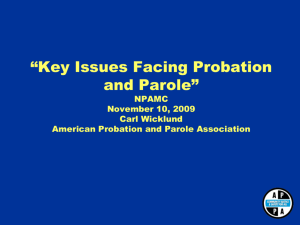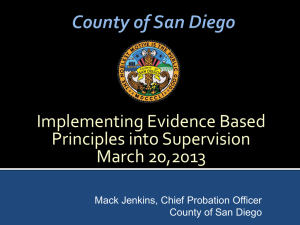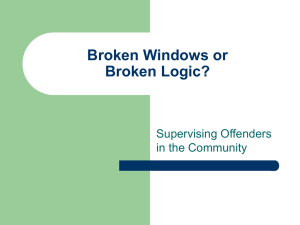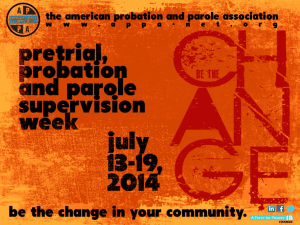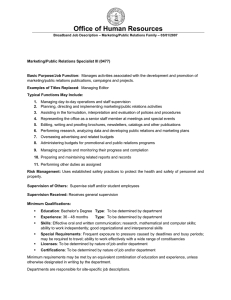M Putting Public Safety First: Executive Summary
advertisement
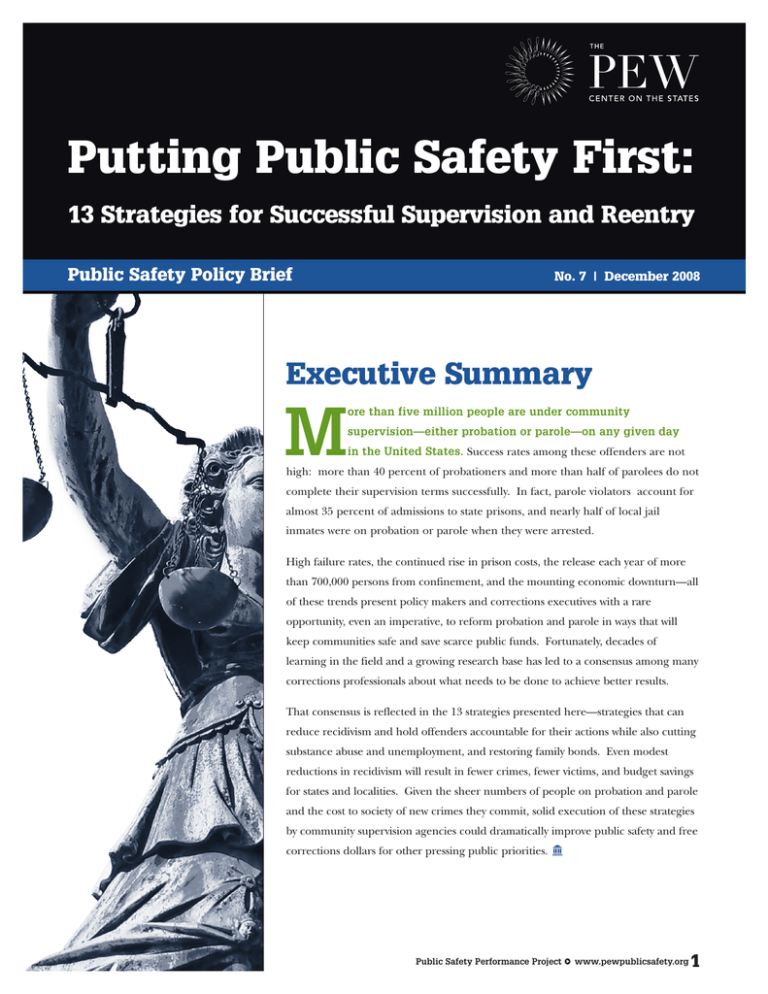
Smart Responses to Parole and Probation Smart Violations Responses to Parole and Probation Violations No. 3 Q November 2007 No. 3 Q November 2007 Putting Public Safety First: 13 Strategies for Successful Supervision and Reentry Public Safety Policy Brief No. 7 | December 2008 Executive Summary M ore than five million people are under community supervision—either probation or parole—on any given day in the United States. Success rates among these offenders are not high: more than 40 percent of probationers and more than half of parolees do not complete their supervision terms successfully. In fact, parole violators account for almost 35 percent of admissions to state prisons, and nearly half of local jail inmates were on probation or parole when they were arrested. High failure rates, the continued rise in prison costs, the release each year of more than 700,000 persons from confinement, and the mounting economic downturn—all of these trends present policy makers and corrections executives with a rare opportunity, even an imperative, to reform probation and parole in ways that will keep communities safe and save scarce public funds. Fortunately, decades of learning in the field and a growing research base has led to a consensus among many corrections professionals about what needs to be done to achieve better results. That consensus is reflected in the 13 strategies presented here—strategies that can reduce recidivism and hold offenders accountable for their actions while also cutting substance abuse and unemployment, and restoring family bonds. Even modest reductions in recidivism will result in fewer crimes, fewer victims, and budget savings for states and localities. Given the sheer numbers of people on probation and parole and the cost to society of new crimes they commit, solid execution of these strategies by community supervision agencies could dramatically improve public safety and free corrections dollars for other pressing public priorities. Public Safety Performance Project Q www.pewpublicsafety.org 1 Smart Responses to Parole and Probation Smart Violations Responses to Parole and Probation Violations No. 3 Q November 2007 No. 3 Q November 2007 1. Define Success as Recidivism Reduction and Measure Performance The Pew Charitable Trusts 1025 F Street, NW Suite 900 Washington, DC 20004-1409 www.pewtrusts.org ABOUT THIS BRIEF In 2007, the JEHT Foundation, in collaboration with the National Institute of Corrections (NIC), asked the Urban Institute to convene two meetings with national experts on the topic of community supervision. The goal of these meetings was to articulate participants’ collective best thinking on parole and probation, violation and revocation practices, and what contributes to effective community supervision. Over the course of these meetings, participants identified the supervision policies and strategies that would help policy makers and practitioners improve public safety and make the best use of taxpayers’ dollars. The 13 strategies outlined in this brief are the result of these discussions and a review of the research literature. A longer paper, supported by the JEHT Foundation, NIC, and the Bureau of Justice Assistance, describes each of the 13 strategies in more detail. It also includes examples from the field, and is available at http://www.urban.org/url.cfm?ID=411791. ABOUT THE AUTHORS This document was written for the Pew Center on the States’ Public Safety Performance Project by Amy L. Solomon, Jesse Jannetta, Brian Elderbroom, Laura Winterfield, and Jenny W.L. Osborne of the Urban Institute; Peggy Burke and Richard P. Stroker of the Center for Effective Public Policy; Edward E. Rhine of the Ohio Department of Rehabilitation and Correction; and William D. Burrell, a corrections management consultant. ABOUT THE PROJECT Launched in 2006 as a project of the Pew Center on the States, the Public Safety Performance Project seeks to help states advance fiscally sound, data-driven policies and practices in sentencing and corrections that protect public safety, hold offenders accountable, and control corrections costs. The Pew Charitable Trusts applies the power of knowledge to solve today’s most challenging problems. Our Pew Center on the States identifies and advances effective policy approaches to critical issues facing states. Probation and parole agencies—like all agencies—should define their mission, be clear about criteria for success and set benchmarks for performance. Most practitioners would agree that public safety is, and always has been, an important goal of their agencies. But the typical strategies employed to accomplish that goal tend to focus on catching offenders when they do something wrong—“trail ‘em, nail ‘em and jail ‘em” as the saying goes. Failing to define success as recidivism reduction, and holding supervision officers accountable to that standard, will result in a continued emphasis on “outputs” (such as the number of contacts probation officers have with their probationers), at the expense of the public safety outcomes that matter most. In order to accomplish their public safety mission, parole and probation agencies should adopt risk reduction and behavior change strategies and measure their performance against the standard of recidivism reduction, substance abuse, employment, victim restitution and other reintegration outcomes. 2. Tailor Conditions of Supervision Probationers and parolees are often subject to a long, generic list of conditions of supervision that may be unrealistic for any individual to meet, let alone those struggling to hold a job, support their families and stay sober. Many in the field agree that conditions of release should instead reflect what Carl Wicklund, executive director of the American Probation and Parole Association, refers to as the “three R's” of supervision conditions: Parole and probation conditions should be Realistic, Relevant, and Research-based. Realistic conditions are few in number and attainable, and include only those rules for which the agency is prepared to consistently hold supervisees accountable. Relevant conditions are tailored to the individual risks and needs most likely to result in new criminal behavior. Research-based conditions are supported by evidence that compliance with them will change behavior and result in improved public safety or reintegration outcomes. 3. Focus Resources on Higher Risk Offenders Research has demonstrated that evidence-based interventions directed towards offenders with a moderate to high risk of committing new crimes will result in better outcomes for both offenders and the community. Conversely, treatment resources targeted to low-risk offenders produce little, if any, positive effect. In fact, despite the appealing logic of involving low-risk individuals in intensive programming to prevent them from graduating to more serious behavior, numerous studies show that certain programs may actually worsen their outcomes. By limiting supervision and services for low-risk offenders and focusing on those who present greater risk, parole and probation agencies can devote limited treatment and supervision resources where they will provide the most benefit to public safety. 4. Frontload Supervision Resources Research clearly identifies the period immediately following release from prison and jail as a particularly high-risk time for offenders. Not only is the risk of new crimes greatest during this period, but offenders often have a heightened need for substance abuse treatment, mental health, housing and other services as well. Parole and probation agencies should respond by concentrating resources in the first few days and weeks of supervision, including reaching into correctional institutions to begin the case planning process for those who will be supervised after release. 2 Public Safety Performance Project Q www.pewpublicsafety.org Putting Public Safety First: 13 Strategies for Successful Supervision and Reentry No. 7 Q December 2008 Frontloading resources has the obvious benefit of providing oversight and treatment when it is most needed. It also helps identify the cases that warrant enhanced supervision and those that do not. Offenders who consistently meet parole and probation conditions may require less supervision later on, thus offsetting the cost of shifting resources upfront. Simply increasing surveillance without a strategy for addressing offenders’ criminal risk factors, however, will most likely lead to finding more violations without affecting behavior change or preventing crime. 5. Implement Earned Discharge Providing incentives for meeting case-specific goals of supervision is a powerful tool to enhance individual motivation and promote positive behavior change. Many experts recommend a system of earned discharge whereby lower risk probationers and parolees can earn their way off supervision by adhering to specific goals and strict guidelines. An opportunity to reduce a term of supervision can be a strong incentive for offenders to meet supervision requirements, find and retain a job, stay sober or in treatment, and participate in the programs most likely to reduce recidivism. It also further helps supervision agencies frontload and concentrate their resources on higher-risk offenders. 6. Supervise Offenders in Their Communities In a system of place-based supervision, parole and probation officers have geographically-based caseloads and may have “satellite” offices located in the communities in which high concentrations of their supervisees live and work. By supervising offenders where they live, fostering relationships with those who know them best, and becoming familiar with local resources and high-risk areas, parole and probation officers are much better positioned to manage their caseloads. Further, organizing caseloads by neighborhood efficiently allocates scarce resources and reduces costly and timeconsuming officer travel. This model contrasts sharply with the conventional model of “fortress” supervision, in which officers hunker down in large, centrally located headquarters and see offenders only from across a desk in the office environment. 7. Engage Partners to Expand Intervention Capacity Given the substantial treatment, health, housing, education and employment needs of parolees and probationers, it is essential for supervision agencies to partner with other organizations such as community health care providers, housing authorities, substance abuse treatment providers, mental health service providers, workforce development boards, faith-based organizations, and other community organizations. Jails and prisons also are critical partners, as they typically gather information, assessments and program intervention information that will be critical to successful supervision. Greater coordination between such organizations will enhance the capacity of supervision agencies to help keep offenders crime- and drug-free. 8. Assess Criminal Risk and Need Factors Supervision agencies should use reliable assessment instruments to identify both risk and need factors and link the results to a supervision case plan. Assessment instruments analyze offenders’ criminal histories in combination with their responses during structured interviews and produce a score that indicates whether they are at low, medium or high risk of reoffending. Research has shown that once these tools are scientifically validated for the specific offender populations to be supervised, they are far better than individual judgment at identifying risk levels and the attitudes and behaviors that drive offenders’ criminal activity. There is broad agreement among experts that such instruments should be used to determine the intensity of supervision and types of services that offenders receive. Some jurisdictions are beginning to use assessment tools prior to sentencing. This allows judges to use the instruments’ predictive power to help make decisions about whether to sentence a defendant to incarceration or what conditions of probation to set. By identifying high-risk offenders, as well as those who may require minimal monitoring and intervention, assessment instruments serve as a guide for the efficient use of resources. 9. Balance Surveillance and Treatment in Case Plans Case plans should reflect individual criminal risk factors and treatment needs in addition to surveillance requirements and obligations to meet with the probation or parole officer. Research has repeatedly shown that a combination of surveillance and treatment is more effective at reducing recidivism than a singular reliance on monitoring and control alone. Cognitive-behavioral interventions, and certain community-based drug treatment, and education and job assistance programs have been proven to contribute to lower recidivism rates and should be considered in the development of supervision plans. Ideally, supervision case plans will be built on empirical risk and need assessments, incorporate offender goals, enhance individual motivation, and consider the input of stakeholders such as corrections officials, law enforcement, victims, family members, and community-based service organizations. Assessment and case planning for offenders returning from prisons and jails should begin shortly after admission and be carefully coordinated with community supervision staff to assure more successful reentry. Public Safety Performance Project Q www.pewpublicsafety.org 3 Putting Public Safety First: 13 Strategies for Successful Supervision and Reentry No. 7 Q December 2008 10. Involve Offenders in the Supervision Process 13. Respond to Violations with Swift and Certain Sanctions Supervision should evolve from a contact-driven system to a behavioral management model in which the individual being supervised is an active participant in the development of the case plan. The results of the risk assessment will identify the key components of the plan, and the supervision officer is responsible for ensuring it protects the public and holds offenders accountable. But parolees and probationers also may have valuable input, especially on the sequencing of goals and the roles of family or clergy. As active participants in the process, they will feel an increased sense of accountability and motivation, resulting in better outcomes and greater public safety. Many parolees and probationers are sent to prison for technical violations of their supervision conditions, such as failing to attend drug treatment, rather than for committing a new criminal offense. Many of these violators can be held accountable in the community without compromising public safety, thus conserving prison beds for violent, serious and persistent offenders. In this model, the routine interaction between parole and probation officers and their charges is itself an intervention. Officers can enhance offenders’ engagement in the process of behavior change by clearly communicating conditions of supervision, reviewing assessment information and developing case plans with offenders, working with them to update and modify goals and supervision case plans as appropriate, and explaining the reasoning behind such adjustments. 11. Engage Informal Social Controls Only a small fraction of an offender’s time is spent interacting with his parole or probation officer, even under the most intensive supervision regimes. Practitioners and academics alike have long known that relationships with family, friends and employers are more effective than formal legal controls in promoting positive behavior change and reducing recidivism. In recognition of this, parole and probation officers should be encouraged to incorporate offenders’ support networks into the assessment, case planning, and supervision process, and to be trained to recognize where these networks exist and how to engage them. 12. Use Incentives and Rewards Research indicates that positive reinforcement, incentives and rewards are powerful tools in the supervision process. By employing them for progress, along with sanctions for violations, parole and probation officers can enhance offender motivation, support positive behavior change and reduce recidivism. Focusing on the gains that offenders have made can promote adherence to supervision conditions and encourage positive responses. Examples of incentives and rewards include awarding certificates of achievement, reducing reporting requirements, deferring a monthly payment, removing conditions (such as home detention or curfew), or asking the offender to be a “mentor” to others. Just as with sanctions, incentives and rewards should be provided with certainty and in a timely fashion to have the greatest impact on behavior change. 4 Public Safety Performance Project Q www.pewpublicsafety.org High-risk offenders who present a threat to the community should be returned to prison when they commit a serious violation or new crime. However, there are many probationers and parolees whose minor violations would be better and more cost-efficiently met with responses that are both proportional to the seriousness of the violation and address the situations that may have led to the behavior. Many jurisdictions have established guidelines that set out clear penalties—low intensity interventions like community service for minor violations and more restrictive options such as very short jail stays for serious infractions. The deterrent impact of the sanctions will be enhanced if they are imposed as quickly as possible after they are detected. For appropriate violations, certain, swift and graduated sanctions can be more effective at preventing relapse and future offending (and at the same time be less expensive) than revocation to prison. Conclusion The 13 strategies presented here illustrate what evidence, research and practitioner expertise suggest probation and parole supervision should look like. Community supervision agencies may not be able to implement all of the strategies in the short run. Nor can agencies accomplish them on their own. They will need the support of leaders in the executive, legislative and judicial branches of government, as well as allied agencies, law enforcement and community organizations. But getting supervision right requires a willingness to apply the 13 strategies through a multi-year effort. Adopted alone, each strategy will produce a positive but limited impact on recidivism and other key performance measures. Implemented together, they have the potential to yield valuable cost savings and transform community supervision into a powerful force for public safety.
